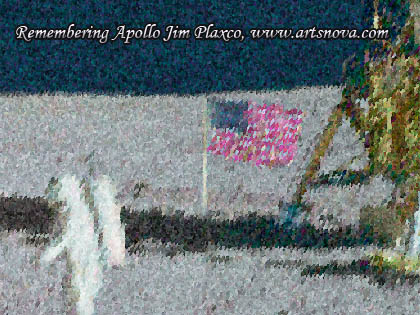Remembering Apollo

A section of the Remembering Apollo digital painting
I was recently reading about the NASA pull back on its plan to send humans back to the Moon (see NASA may abandon plans for moon base) and could only shake my head in dismay.
A few weeks ago I had the chance to speak to the high school students from three high schools all of whom were members of the Space Exploration Club. My presentation was about what it takes to design and build a lunar base. As a parallel, I used the Army's experiences with planning, building, and maintaining Camp Century. Camp Century is/was the fabled nuclear powered city under the ice. Today the name Camp Century is probably best known for its ice core samples which have played a prominent role in helping us to understand the Earth's climate record. Camp Century was abandoned in 1966 due to the shifting movement of the glacial ice cap. This city was eventually crushed by that slow, steady movement.
I spoke to this group of 50 high school students about Camp Century and lunar bases for a solid hour and then answered questions for maybe another half hour. For me, it was a very enjoyable experience seeing how interested these students were in space exploration, science, and energy.
And then I read that NASA may not build a lunar outpost. That plus the news that Orion will be sized to carry only 4 instead of 6 astronauts is a clear indication that NASA's fortunes have taken a turn for the worse. I find it hard to understand how the political leaders who spend so much time and effort telling us that we must be graduating more engineers and scientists can simultaneously scale back the one program that is such a source of inspiration to students wanting to become engineers and scientists. Does the left brain know what the right brain is up to in Washington?
This got me to thinking about the Apollo missions and the large influence that they had on my life from a philosophical perspective. The quest to understand and know the universe combined with our efforts to grow humanity so that it can exist beyond the confines of Planet Earth is a noble adventure that should be emphasized rather than trivialized. It was the contrast between what is and what could be that led me to create Remembering Apollo because right now memories of man on the Moon is all we have. I wonder just how long we can survive living off memories.
For me Remembering Apollo captures the most important features of the Apollo missions. There is the barren lunar landscape so aptly described as "magnificient desolation" by Apollo 11 astronaut Buzz Aldrin. There is the Lunar Module – the machine that made it possible for the astronauts to land on and return from the Moon. Then there is the Astronaut – the most important element that made the Apollo missions distinct from all the other space exploration missions, mostly forgotten robotic missions to the Moon. In the book Robots in Space: Technology, Evolution, and Interplanetary Travel, an unnamed NASA official is quoted as saying “We don't give ticker tape parades for robots.” We remember Neil Armstrong, Buzz Aldrin, and Michael Collins, but who remembers Ranger, Lunar Orbiter, or Surveyor? The last element is the United States flag, the symbol of the nation that went to the Moon in peace "for all mankind." I must say how fortunate I consider myself to be in being a witness to this, humanity's first small step into the wider cosmos.
Creating the Remembering Apollo digital painting
The Remembering Apollo digital painting is 5580 pixels wide by 3412 pixels tall and was digitally painted using the same technique that I developed for Quantum Moon. The digital tools that I used were a Wacom tablet, Adobe Photoshop, and a digital painter program of my own design. For other details on the picture, as well as to see both the complete picture and a full size section of the art, see the Remembering Apollo gallery page.
Ad Astra, Jim
| Return to the Blog Index | This entry was posted on Tuesday, May 12th, 2009 at 9:23 am and is filed under Space Art, Space Exploration.